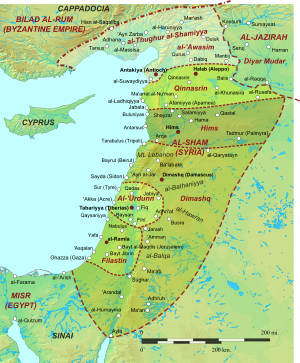Jund Filastin
Jund Filasṭīn (Arabic: جُنْد فِلَسْطِيْن, "the military district of Palestine") was one of the military districts of the Umayyad and Abbasid province of Bilad al-Sham (Syria), organized soon after the Muslim conquest of the Levant in the 630s. Jund Filastin, which encompassed most of Palaestina Prima and Palaestina Tertia, included the newly established city of Ramla as its capital and eleven administrative districts (kura), each ruled from a central town.[1]
| Jund Filastin | |||||||||||
|---|---|---|---|---|---|---|---|---|---|---|---|
| Province of the Umayyad, Abbasid and Fatimid Caliphates | |||||||||||
| 660s/680s–late 11th century | |||||||||||
 Arab Syria (Bilad al-Sham) and its provinces under the Abbasid Caliphate in the 9th century | |||||||||||
| Capital | Ludd, Ramla, Jerusalem | ||||||||||
| History | |||||||||||
• Established | 660s/680s | ||||||||||
• Seljuk attacks, First Crusade | late 11th century | ||||||||||
| |||||||||||
| Today part of | |||||||||||
History and structure
According to al-Biladhuri, the main towns of the district, following its conquest by the Rashidun Caliphate, were Gaza, Sebastia, Nablus, Caesarea, Ludd, Yibna, Imwas, Jaffa, Rafah, and Bayt Jibrin. At first, under the early Umayyad caliphs, Ludd served as the district capital. After the caliph Sulayman ibn Abd al-Malik founded the nearby city of Ramla, he designated it the capital, and most of Ludd's inhabitants were forced to settle there. In the 9th century, during Abbasid rule, Jund Filastin was the most fertile of Syria's districts, and contained at least twenty mosques, despite its small size.[2]
The Arab tribes that settled Jund Filastin after the Muslim conquest were the Lakhm, Kindah, Qays, Amila, Judham and the Kinana; at the time of the Arab conquest, the region had been inhabited mainly by Aramaic-speaking Miaphysite Christian peasants. The population of the region did not become predominantly Muslim and Arab in identity until several centuries after the conquest. At its greatest extent, Jund Filastin extended from Rafah in the south to Lajjun in the north, and from the Mediterranean coast well to the east of the southern part of the Jordan River. The mountains of Edom, and the town of Zoar (Sughar) at the southeastern end of the Dead Sea were included in the district. However, the Galilee was excluded, being part of Jund al-Urdunn in the north.[2]
After the Fatimids conquered the district from the Abbasids, Jerusalem eventually became the capital, and the principal towns were Ashkelon, Ramla, Gaza, Arsuf, Caesarea, Jaffa, Jericho, Nablus, Bayt Jibrin, and Amman.[2] The district persisted in some form until the Seljuk invasions and the Crusades of the late 11th century.
See also
- Greater Syria
- Levant
- Mashriq
- Middle East
- Shaam
- Syria Palaestina
- 'Ubadah ibn al-Samit
References
- Avni, Gideon (2014). "Shifting Paradigms for the Byzantine–Islamic Transition". The Byzantine-Islamic Transition in Palestine: An Archaeological Approach. Oxford: Oxford University Press. ISBN 9780199684335.
- Estakhri quoted by Le Strange, G. (1890). Palestine Under the Moslems: A Description of Syria and the Holy Land from A.D. 650 to 1500. London: Committee of the Palestine Exploration Fund. pp. 25–30. OCLC 1004386.CS1 maint: ref=harv (link)